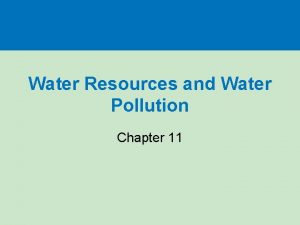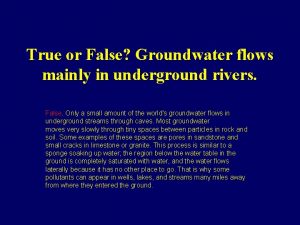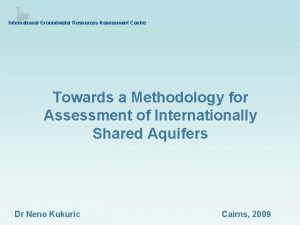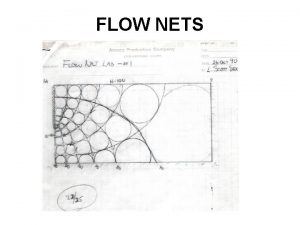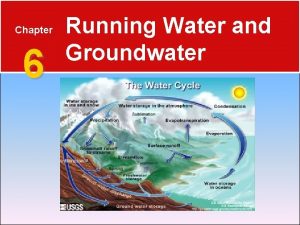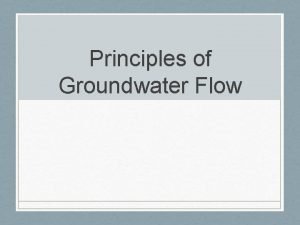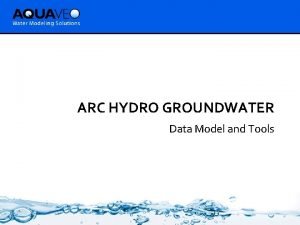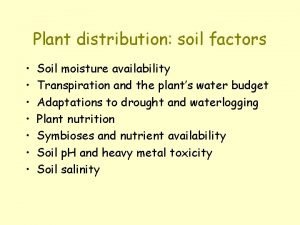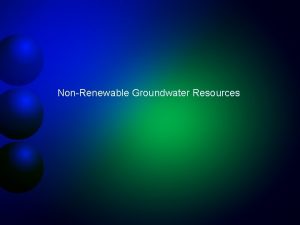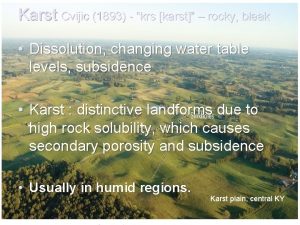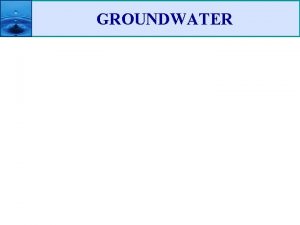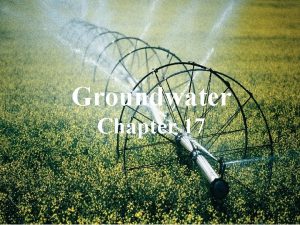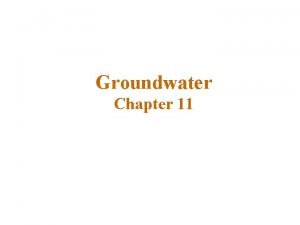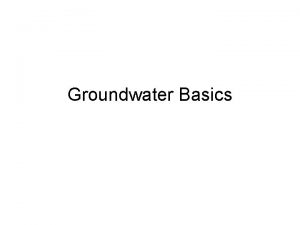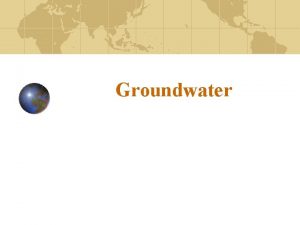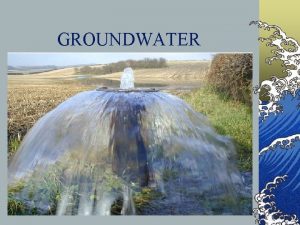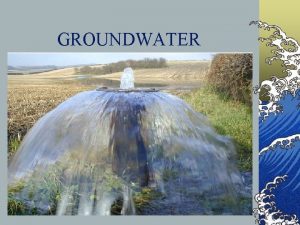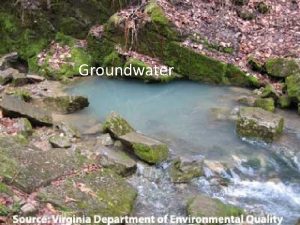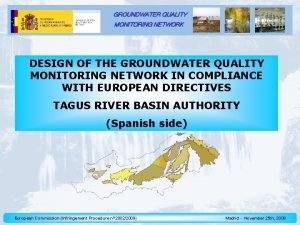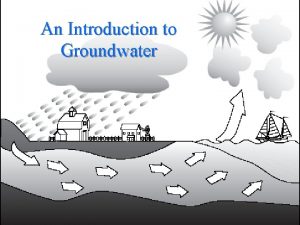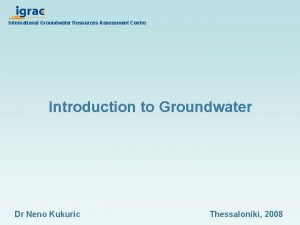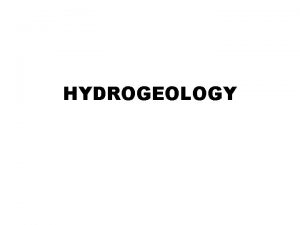Groundwater Quality UNIT 5 Groundwater quality Introduction Quality






















- Slides: 22

Groundwater Quality UNIT 5

Groundwater quality: Introduction � Quality of groundwater is as important as its quantity. � All groundwater contains salts that are derived from the location and past movement of the water. � The quality of the required groundwater supply depends on its purpose therefore needs for drinking water, industrial water and irrigation water vary widely.

Groundwater quality: Introduction �To establish the quality criteria it is necessary to measure the chemical, physical, biological and radiological constituents of groundwater. �Standard methods of reporting and presenting groundwater quality parameters help in comparing the comparison of water quality from different sources.

Measures of water quality �The chemical characteristics of groundwater are determined by the chemical and biological reaction in the zones through which the water moves. �In specifying the quality characteristics of groundwater, chemical, physical and biological analyses are normally required.

Measures of water quality � Natural inorganic constituents commonly dissolved in water that are most likely to affect water use include: • • • Bicarbonate Chloride Sulphate Fluoride Iron Magneisum Calcium Sodium and Manganese

Measures of water quality � In addition there are other minor constituents which are present and are reported in elemental form. � Water quality analysis also includes measurement of p. H and specific electrical conductance. � Properties of groundwater evaluated in physical analysis include temperature, color, turbidity odor and taste. � Bacteriological analysis includes tests to detect the presence of coliform bacteria which indicates the sanitary quality of water for human consumption.

Major Cations �The cations which are present in greater concentration (almost always greater than 1 mg/L) are called the major cations. �They • • include Calcium (Ca 2+) Magnesium (Mg 2+) Sodium (Na+) Potassium (K+)

Major Anions �The anions which are present in higher concentrations (normally higher than 1 mg/L) are called major anions. �The include • Bicarbonate (HCO 3) • Sulfate (SO 4)2 • Chloride (Cl-)

Minor ions � Cations and anions present in the concentration range of 0. 01 -1. 0 mg/L are know as minor ions. � They • • include Iron Manganese Nitrate Ammonium Hydrogen Sulfide Fluoride Boron

Trace ions � Virtually all the elements from the periodic table which have not been included as major air minor ions can be included in the category of trace ions. � Their concentration range in groundwater is normally less than 0. 01 mg/L. � Where the ions in question are toxic to humans (e. g. Cadmium, Mercury) and/or to wildlife (e. g. Aluminum, Zinc, Copper) their importance in practical terms far outweigh the contribution to TDS of the water.

Hardness � Hardness of presence of groundwater results from the Calcium and Magnesium in � The total hardness HT can be given by the formula HT = 2. 5 Ca +4. 1 Mg � where Ca and Mg concentrations are in mg/l. Hardness (mg/l) as Ca. CO 3 Water Class 0 -75 Soft 75 -150 Moderately Hard 150 -300 Hard Over 300 Very Hard

Total Dissolve Solids (TDS) � The TDS content of the water is the most common measure of the content of overall dissolved mineral matter in water. � It is also the best measure of the salinity of water. � TDS can be calculated by summing the concentrations of the individual dissolved components of the water. � Based on the TDS of water, it is possible to classify the water as follows. Type of Water TDS value (mg/L) Fresh Less than 1000 Brackish 1000 -10, 000 Saline 10, 000 -100, 000 Hyper Saline Greater than 100, 000

p. H � p. H is the most common measure of the acidity/alkalinity balance in a solution. � Values units). � Water of acidity fall within the range of 0 -14 (no having a p. H of 7 is said to be neutral. � If the p. H is less than 7, the water is said to be acidic. � If the p. H is more than 7 the water is said to be alkaline

Chemical Analyses: TDS by Electrical Conductance �A rapid determination of total dissolved solids can be made by measuring the electrical conductance of a groundwater sample. � Conductance of a given groundwater sample increases with the increase in salt concentration. � Specific conductance microsiemens/cm. is measured in

Chemical Analyses �Once a sample of groundwater has been analysed in the laboratory, methods for reporting water analyses must be considered. �From an understanding of expressions and units for describing water quality, standards can be established so that the analyses can be interpreted in terms of the ultimate purpose of water supply.

Chemical Analyses: Concentration by weight �Concentration of the common ions found in groundwater are reported by weight per volume units of milligrams per litre (mg/l). �The total dissolved solids(TDS) is also reported in this manner. �Parts per million (ppm) can also be used at times instead of mg/l.

Chemical Analyses: Chemical Equivalence � Positively charged cations and negative anions combine and dissociate in definite weight ratios. � By expressing ion concentration in equivalent weights, these ratios are readily determined because one equivalent weight of a cation will exactly combine with one equivalent weight of an anion. � When the concentrations in mg/l is divided by the combining weight of the cation or anion the equivalent weight expressed in milliequivalets per liter (meq/l) results. � In application, therefore it may be expected that of the total dissolved solids in groundwater sample, the sum of cation and the sum of anion when expressed in meq/l should be equal. � If the chemical analyses of the various ionic constituents indicates a difference from this balance, it may be concluded that eithere are other undetermined constituents present or there is error in the analyses.

Cation-Anion Balance � Once the chemical analysis is complete, the final test of quality is provided by the principle of electroneutrality which states that water is electrically neutral and does not carry any positive or negative charge. � Therefore the some of the positively charged (cations) dissolved ions in water must be equal to the sum of the negatively (anions) charged dissolved ions in water. � This can be checked by the cation-anion balance (CAB) of the water which is defined as � CAB % = (sum of cations) - (sum of anions) ----------------------x 100 (sum of cations) + (sum of anions) � The concentration of the ions are expressed in meq/L � If the value of CAB is less than 5%, the analysis is said to be sufficiently accurate for all uses.

Graphic representation of groundwater quality: Pie Charts �The simplest way of representing groundwater quality are the pie-charts. �The diameter of the pie chart can be scaled according to the concentration of the TDS

Graphic representation of groundwater quality: Bar Graphs � Vertical bar graphs are widely used for showing the chemical quality of groundwater. � The anlysis is shown as a vertical bar having height proportional to the total concentration of cation or anion, expressed in milliequivalets per liter. � The concentrations are divided horizontally to show the concentration of major ions or groups of closely related ions identified by different shading patterns.

Graphic representation of groundwater quality: Stiff Diagarm � Pattern diagrams were first suggested by Stiff for representing chemical analyses. � Concentrations of cations are plotted to the left of a vertical zero axis and the anions to the right. All values are in meq/l. � The resulting point when connected form an irregular polygonal pattern. � Water of similar quality define a distinctive shape.

Graphic representation of groundwater quality: Piper Plot � The most commonly used diagram to interpret the results of water quality is the Piper Plot. � To plot an analysis on a Piper Plot, the cations and anions are first plotted separately in the traingles at the bottom left and right and the lines are drawn upward from the plotting position within both the triangles until the meet within the upper diamond.
 Nj groundwater quality standards
Nj groundwater quality standards Unit 10, unit 10 review tests, unit 10 general test
Unit 10, unit 10 review tests, unit 10 general test The zone of aeration
The zone of aeration Groundwater pollution
Groundwater pollution Most groundwater comes from rain true or false
Most groundwater comes from rain true or false Running water and groundwater
Running water and groundwater Gms groundwater
Gms groundwater Groundwater assessment methodology
Groundwater assessment methodology Water table
Water table Septic tank contamination groundwater
Septic tank contamination groundwater Groundwater flow net
Groundwater flow net The term geologists use for underground water is
The term geologists use for underground water is Chapter 6 running water and groundwater
Chapter 6 running water and groundwater Brain pop water cycle
Brain pop water cycle Rajiv gandhi groundwater raipur
Rajiv gandhi groundwater raipur Hydrolic head
Hydrolic head Permeability of rocks
Permeability of rocks Arc hydro groundwater
Arc hydro groundwater Hydrosphere
Hydrosphere Lenticels
Lenticels Is groundwater a renewable or nonrenewable resource
Is groundwater a renewable or nonrenewable resource Poljes
Poljes How does groundwater rejoin the water cycle
How does groundwater rejoin the water cycle



